Archive:SDG 9 - Industry, innovation and infrastructure (statistical annex)
Build resilient infrastructure, promote inclusive and sustainable industrialisation and foster innovation (statistical annex)
- Data extracted in August 2018. Most recent data: Further Eurostat information, Main tables and Database. Planned article update: September 2019.
This article provides an overview of statistical data on SDG 9 ‘Industry, innovation and infrastructure’ in the European Union (EU). It is based on the set of EU SDG indicators for monitoring of progress towards the UN Sustainable Development Goals (SDGs) in an EU context.
This article is part of a set of statistical articles, which are based on the Eurostat publication ’Sustainable development in the European Union — Monitoring report - 2018 edition’. This report is the second edition of Eurostat’s series of monitoring reports on sustainable development, which provide a quantitative assessment of progress of the EU towards the SDGs in an EU context.
Gross domestic expenditure on R&D

Source: Eurostat (sdg_09_10)
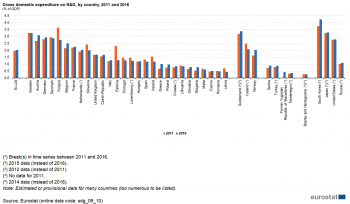
Source: Eurostat (sdg_09_10)
This indicator measures gross domestic expenditure on R&D (GERD) as a percentage of the gross domestic product (GDP). The Frascati Manual defines research and experimental development (R&D) as creative work undertaken on a systematic basis in order to increase the stock of knowledge, including knowledge of man, culture and society and the use of this stock of knowledge to devise new applications [1].
Figure 1 shows that after a prolonged stagnation between 2000 and 2007, R&D intensity has grown slowly. Between 2001 and 2016, R&D intensity grew by an average of 0.9 % per year. Growth was slightly slower in the short-term period between 2011 and 2016, at 0.6 % per year on average. At the current pace of development, the Europe 2020 target of investing 3 % of GDP in R&D by 2020 will not be achieved.
Employment in high- and medium-high technology manufacturing sectors and knowledge-intensive service sectors

Source: Eurostat (sdg_09_20)
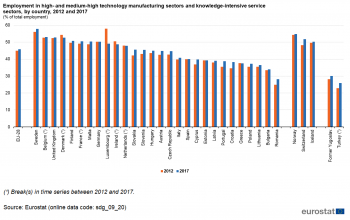
Source: Eurostat (sdg_09_20)
The indicator measures the employment in high- and medium-high technology manufacturing sectors and in knowledge-intensive service sectors as a share of total employment. Data stem from the European Labour Force Survey (LFS). The definition of high- and medium-high technology manufacturing sectors and of knowledge-intensive services is based on a selection of relevant items of the Statistical classification of economic activities in the European Community (NACE) Rev. 2 at 2-digit level and is oriented on the ratio of highly qualified working in these areas.
As shown in Figure 3, the share of employed people working either in high-and medium-high technology manufacturing or in knowledge-intensive service sectors has grown steadily since 2008. In the short-term period since 2012, the increase has amounted to 0.4 % per year on average.
R&D personnel
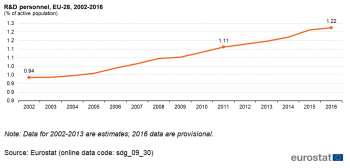
Source: Eurostat (sdg_09_30)
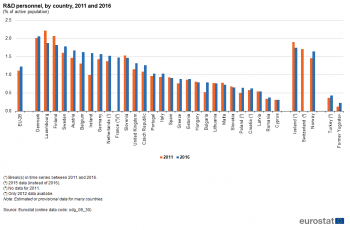
Source: Eurostat (sdg_09_30)
This indicator measures the share of R&D personnel broken down by the following institutional sectors: business enterprise, government, higher education and private non-profit. Data are presented in full-time equivalents as a share of the economically active population (the labour force).
R&D personnel makes up an ever increasing share of the labour force, as shown in Figure 5. Both in the long-term period between 2002 and 2016, and in the short-term period between 2011 and 2016, the share of R&D personnel in the active population increased by 1.9 % per year on average.
Patent applications to the European Patent Office (EPO)
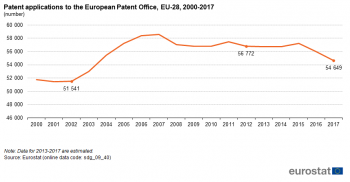
Source: Eurostat (sdg_09_40)

Source: Eurostat (sdg_09_40)
This indicator measures the requests for protection of an invention directed either directly to the European Patent Office (EPO) or filed under the Patent Cooperation Treaty and designating to the EPO (Euro-PCT), regardless of whether they are granted or not. The data shows the total number of applications per country. If one application has more than one inventor, the application is divided equally among all of them and subsequently among their countries of residence, thus avoiding double counting.
Figure 7 shows that patent applications in the EU had increased considerably prior to the economic crisis, and have more or less stagnated ever since, with a slight decrease since 2015. The average increase for the long-term period from 2002 to 2017 amounts to 0.4 % per year. In the short-term period since 2012, patent applications have fallen at an average annual rate of 0.8 %.
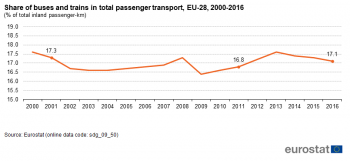
Source: Eurostat (sdg_09_50)
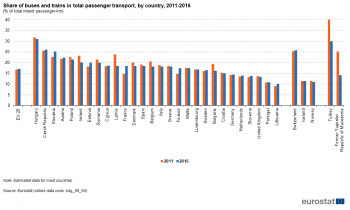
Source: Eurostat (sdg_09_50)
This indicator measures the share of buses, including coaches and trolley-buses, and trains in total passenger transport performance, expressed in passenger-kilometres (pkm). Total passenger transport here includes transport by passenger cars, buses and coaches, and trains, and excludes air and sea transport. All data should be based on movements within national territories, regardless of the nationality of the vehicle. The data collection is voluntary and not fully harmonised at the EU level. Other collective transport modes, such as tram and metro systems, are not included due to the lack of harmonised data.
Figure 9 shows that in the long-term period since 2001 the share of buses and trains in total passenger land transport has fallen moderately, with an average annual decline of 0.1 %. In contrast, in the short-term period between 2011 and 2016 the share increased slightly, with an annual average growth rate of 0.4 %.

Source: Eurostat (sdg_09_60)

Source: Eurostat (sdg_09_60)
This indicator measures the share of rail and inland waterways in total inland freight transport, expressed in tonne-kilometres (tkm). Inland freight transport modes include road, rail and inland waterways. Rail and inland waterways transport is based on movements on national territory, regardless of the nationality of the train or vessel. Road transport is based on all movements of vehicles registered in the reporting country. The redistribution of road transport according to the 'territoriality principle' involves modelling the likely journey itinerary and projecting it on the European road network. Neither sea nor air freight transport are currently represented in the indicator.
Similar to the modal split of passenger transport, the choice of transport mode for inland freight has not changed substantially since 2005. Between 2005 and 2016, the share of rail and inland waterways in total freight transport fell by 0.3 % per year on average. In the short-term period since 2011, the decline has even been stronger, at an average of 1.1 % per year.
See also
Further Eurostat information
Database
- Socioeconomic Development
Dedicated section
Methodology
More detailed information on EU SDG indicators for monitoring of progress towards the UN Sustainable Development Goals (SDGs), such as indicator relevance, definitions, methodological notes, background and potential linkages, can be found in the introduction of the publication ’Sustainable development in the European Union — Monitoring report - 2018 edition’.
Notes
- ↑ Frascati Manual, 2002 edition, § 63.





